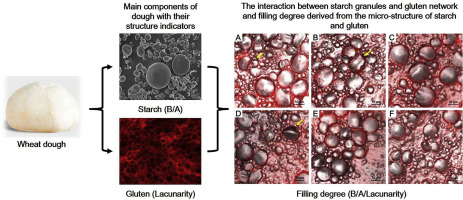当前位置:
X-MOL 学术
›
Food Hydrocoll.
›
论文详情
Our official English website, www.x-mol.net, welcomes your
feedback! (Note: you will need to create a separate account there.)
Influence of gluten and starch granules interactions on dough mixing properties in wheat (Triticum aestivum L.)
Food Hydrocolloids ( IF 11.0 ) Pub Date : 2020-09-01 , DOI: 10.1016/j.foodhyd.2020.105885 Xin Gao , Jingyang Tong , Lei Guo , Liwei Yu , Shaopeng Li , Bingpeng Yang , Libin Wang , Yang Liu , Faji Li , Jun Guo , Shengnan Zhai , Cheng Liu , Ata-ur Rehman , Asgar Farahnaky , Pei Wang , Zhonghua Wang , Xinyou Cao
Food Hydrocolloids ( IF 11.0 ) Pub Date : 2020-09-01 , DOI: 10.1016/j.foodhyd.2020.105885 Xin Gao , Jingyang Tong , Lei Guo , Liwei Yu , Shaopeng Li , Bingpeng Yang , Libin Wang , Yang Liu , Faji Li , Jun Guo , Shengnan Zhai , Cheng Liu , Ata-ur Rehman , Asgar Farahnaky , Pei Wang , Zhonghua Wang , Xinyou Cao

|
Abstract Wheat flour dough can be regarded as a complicated mixture in which gluten forms a continuous three-dimensional network filled with starch particles. Previous studies have concentrated on the influences of either gluten or starch alone on the rheological properties of wheat dough and found the components of gluten and starch responsible for the dough behavior, including use of parameters, such as the content of protein, wet gluten and amylose, for the evaluation of wheat quality. Earlier, in our study of six wheat materials, significant differences were observed in size distribution of starch granules affecting the dough mixing behavior. However, to our knowledge little research has been undertaken on the association of starch granules and protein networks on dough formation. In this study, the six wheat lines were further explored for the effect of gluten-starch interactions on dough properties. In order to achieve this, the wheat flour samples were quantified for gluten secondary structures, percentage of unextractable polymeric protein, high- to low-molecular-weight glutenin ratio, gluten micro-structure, number distribution of starch granules and moisture distribution in dough samples. A/Lacunarity (A-type starch granule content divided by lacunarity of gluten network) and B/A/Lacunarity (B- to A-type starch granule ratio divided by lacunarity) were proposed to characterize the level of interactions of differently sized starch granules to gluten protein networks in the dough. Results showed that dough stability time increased with the increase of B/A/Lacunarity, as closely packed dough, due to close interaction between starch granules and gluten, exhibited greater dough stability. Application of A/Lacunarity and B/A/Lacunarity as novel indicators is proposed to further elucidate precise influences between starch and gluten for better evaluation of dough properties.
中文翻译:

面筋和淀粉颗粒相互作用对小麦面团混合特性的影响(Triticum aestivum L.)
摘要 小麦面粉面团可以看作是一种复杂的混合物,其中面筋形成一个充满淀粉颗粒的连续三维网络。以前的研究集中于面筋或淀粉单独对小麦面团流变学特性的影响,并发现面筋和淀粉的成分对面团行为负责,包括使用参数,如蛋白质、湿面筋和直链淀粉的含量, 用于评价小麦品质。早些时候,在我们对六种小麦材料的研究中,观察到影响面团混合行为的淀粉颗粒大小分布的显着差异。然而,据我们所知,关于淀粉颗粒和蛋白质网络对面团形成的关联的研究很少。在这项研究中,进一步探索了六个小麦品系,以了解面筋-淀粉相互作用对面团特性的影响。为了实现这一目标,对小麦面粉样品进行了面筋二级结构、不可提取的聚合蛋白百分比、高低分子量谷蛋白比例、面筋微结构、淀粉颗粒数量分布和面团样品中水分分布的定量分析。 . 提出了 A/Lacunarity(A 型淀粉颗粒含量除以面筋网络的空隙度)和 B/A/Lacunarity(B 与 A 型淀粉颗粒的比例除以空隙度)来表征不同大小淀粉颗粒的相互作用水平面团中的面筋蛋白质网络。结果表明,面团稳定时间随着 B/A/Lacunarity 的增加而增加,因为紧密堆积的面团,由于淀粉颗粒和面筋之间的密切相互作用,表现出更大的面团稳定性。提出应用 A/Lacunarity 和 B/A/Lacunarity 作为新指标,以进一步阐明淀粉和面筋之间的精确影响,以更好地评估面团特性。
更新日期:2020-09-01
中文翻译:

面筋和淀粉颗粒相互作用对小麦面团混合特性的影响(Triticum aestivum L.)
摘要 小麦面粉面团可以看作是一种复杂的混合物,其中面筋形成一个充满淀粉颗粒的连续三维网络。以前的研究集中于面筋或淀粉单独对小麦面团流变学特性的影响,并发现面筋和淀粉的成分对面团行为负责,包括使用参数,如蛋白质、湿面筋和直链淀粉的含量, 用于评价小麦品质。早些时候,在我们对六种小麦材料的研究中,观察到影响面团混合行为的淀粉颗粒大小分布的显着差异。然而,据我们所知,关于淀粉颗粒和蛋白质网络对面团形成的关联的研究很少。在这项研究中,进一步探索了六个小麦品系,以了解面筋-淀粉相互作用对面团特性的影响。为了实现这一目标,对小麦面粉样品进行了面筋二级结构、不可提取的聚合蛋白百分比、高低分子量谷蛋白比例、面筋微结构、淀粉颗粒数量分布和面团样品中水分分布的定量分析。 . 提出了 A/Lacunarity(A 型淀粉颗粒含量除以面筋网络的空隙度)和 B/A/Lacunarity(B 与 A 型淀粉颗粒的比例除以空隙度)来表征不同大小淀粉颗粒的相互作用水平面团中的面筋蛋白质网络。结果表明,面团稳定时间随着 B/A/Lacunarity 的增加而增加,因为紧密堆积的面团,由于淀粉颗粒和面筋之间的密切相互作用,表现出更大的面团稳定性。提出应用 A/Lacunarity 和 B/A/Lacunarity 作为新指标,以进一步阐明淀粉和面筋之间的精确影响,以更好地评估面团特性。









































 京公网安备 11010802027423号
京公网安备 11010802027423号